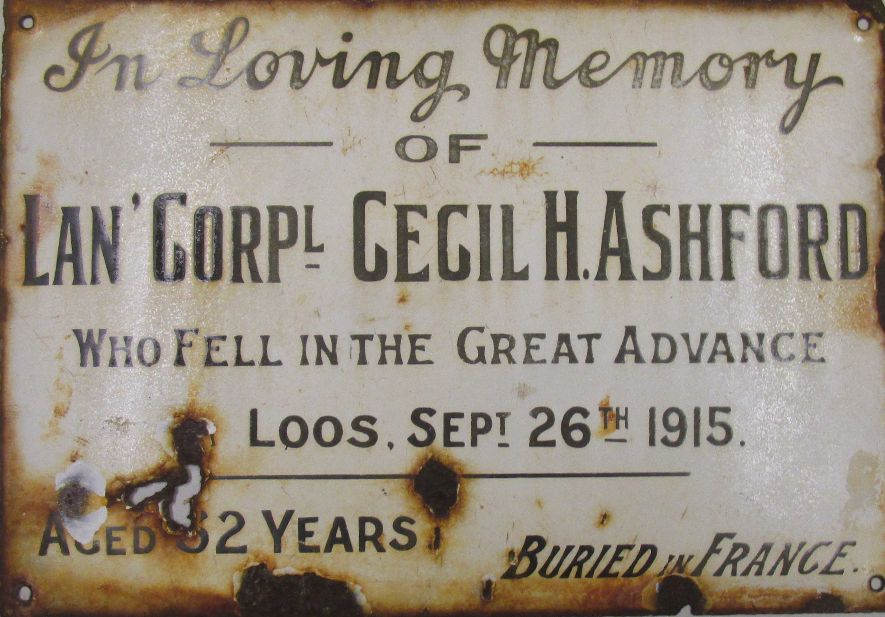10138 L/CPL CECIL HARRY ASHFORD
9TH BATTALION SUFFOLK REGIMENT
WHO DIED OF WOUNDS
9TH OCTOBER 1915
AGE 32 YEARS

Cecil, more commonly known as Harry, had been born in Framlingham in 1883 and was the second son and twin to sister Alice born to Sutton, a jeweller and watchmaker and Louisa (née Simpson). By the 1890s the family had moved to Halesworth, where Sutton had set up his watchmaker’s business at No. 8 London Road. On leaving school Harry served his apprenticeship with the Halesworth Printers, Premier Press. By 1911 he had qualified as a compositor and was employed by Messrs Flood and Sons of Lowestoft whilst lodging with the Press family.
At the start of the Great War in 1914, although the Royal Navy ruled the waves with the most powerful fleet afloat, the British regular army with many of its troops overseas, policing the Empire, were not in any state to fight a protracted war against Germany and her allies. At this point the then Secretary for War, Lord Kitchener of Khartoum, announced the formation of a new citizen army to be based around men of a similar social class or walks of life, originating from the same town or village with similar interests such as being members of the local football club etc. These formations were originally known as ‘Pals Battalions’. Shortly after Lord Kitchener’s call to arms (best illustrated by his well-known poster of ‘Your Country Wants You’, Harry stepped forward to enlist in Lowestoft to serve as 3/10138 a Private Soldier in the 3rd (Reserve) Battalion, Suffolk Regiment then based in Felixstowe. He was then posted to the 9th (Service) Battalion of his county regiment. The inclusion of ‘service’ in their title indicated that they were a Kitchener’s battalion, which had been first formed at Bury St Edmunds in September 1914.
As can be seen from the photograph of Harry taken before he crossed to France, due to the large number of men enlisting, standard khaki uniforms were not available. In 1914, many of the new battalion’s soldiers would have been dressed in obsolete blue uniforms which they despised. After completing training, during which he was promoted to L/Cpl he crossed to France with his battalion on the 30th August 1915.
Less than a month later, the 9th Suffolks entered the fray, when they took part in their first action of the war, the Battle of Loos, which they with their comrades of the 24th Division joined on the 25th September 1915. Initially forming up in the area of the northern French city of Bethune, their task was to carry out a follow up attack on the German support line, after the main assault had overrun the enemy’s front line trenches. Their order to advance came at 11.25 on the morning of the 26th September whereupon each platoon of the battalion mounted the trench parapet and began to advance forward, whilst under a very heavy barrage being fired by the German artillery. After making some two hundred yards, their advance gradually slowed and then ground to a halt as many of their inexperienced soldiers began to fall either dead or wounded. Eventually the order to withdraw was given, with those able helping their injured comrades to the rear. From what information is available, it appears that Harry was one of those who had suffered wounds from which he eventually would die from on the 9th October 1915.
For some time no official notification of Harry’s death was made to his family with them initially receiving the news from a comrade who helped to bury him. As with many other cases during the ebb and flow of the Great War battles, Harry’s grave was lost with his name joining many thousands of others that are remembered on the Menin Gate Memorial to the missing in Belgium.
Shortly after, as their own memorial to their son’s life, the family arranged for an enamel sign to be produced to remember Harry’s sacrifice. This it is believed was placed somewhere in the Halesworth Cemetery. Many years later it was found in a hedge and handed into the Towns museum where it remains today. As well as being remembered on the Halesworth War Memorial, his name is also to be found on the Framlingham Memorial and that at St Margaret’s Church, Lowestoft.
It was during the withdrawal that 3/10133 Sgt Arthur Saunders of the battalion became the first of two members of the Suffolk Regiment to win a Victoria Cross during the Great War. Arthur who hailed from the parish of St. John’s, Ipswich must have enlisted on the same day as Harry as their regimental numbers are within four digits of each other.
After Harry’s death his father Sutton now living with his wife in Lowestoft, received a combined War Gratuity of £7.12s.6d (£7.63p) for the loss of their son.
He would have also been able to claim Harry’s medal entitlement of the 1915 Star medal trio with his named memorial plaque and scroll.
The location of these awards are not known.


